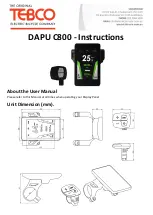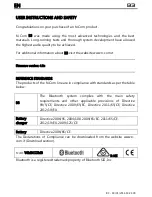
M
P Ser
ies
L
oa
d B
ars
Q
uic
kst
art
G
ui
de
3
5
Testing
Once installed, you should test with a weigh scale indicator.
1.
Connect the load bar cables to a Tru-Test indicator.
2.
Turn on and zero the indicator.
3.
Put a test weight (which may be yourself or another person) at one end of the platform/crate and note the stable
reading on the indicator.
4.
Put the test weight at the other end of the platform/crate and note the stable reading on the indicator.
5.
Remove the test weight and note whether the reading returns to zero.
6.
If the two readings differ by more than 1 kg OR the reading does not return to zero, see the Troubleshooting section.
Periodically repeat the above tests during use and also before first use if the equipment has not been used for some time.
6
Troubleshooting
Fault
Remedy
Reading does not return to
zero between animals
OR
Difference in readings at each
end of the platform
OR
Under reading (readings
lighter than expected).
•
Ensure that the platform/crate is not touching objects that may alter the
weights. Typical causes are binding against fixed metalwork or build up of dirt.
•
Check that the load bar feet are sitting evenly on the ground.
•
Check that bolt holes are not misaligned, as this may put a residual load on the
load bars.
Reading is unstable.
•
Moisture in the load bar connectors. Remove moisture from the plugs and caps
using methylated spirits, ethyl alcohol, or a suitable electrical contact cleaner.
Do not use stronger spirits, as they may react with the plastic.
•
Damaged cable. Return the load bar for servicing.
•
Moisture in load cells. Return the load bar for servicing.
Reading moves, display shows
under load or overload.
Damaged cable. Return for service.




































